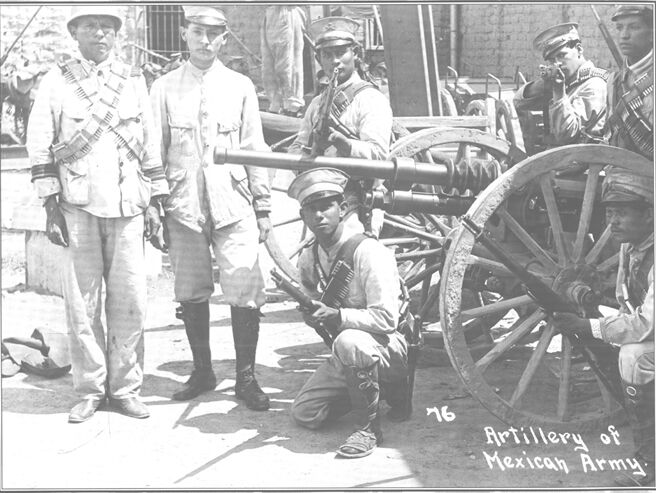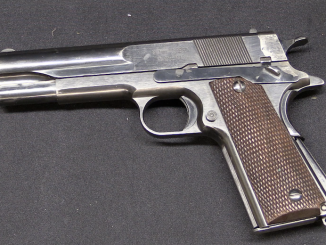
Published in Osprey’s “The Mexican Revolution 1910-20” book, this photo postcard shows a very rare Hotchkiss 37mm automatic cannon. It was designed to compete with the Vickers Pom-Pom, and apparently was only bought in small numbers by the Mexican Army and the Japanese Navy. Sent to us by Alex A. – thanks, Alex!



Badgers? BADGERS?! We don’ need no stinkin’ badgers!
(siiigh)…why do THEY get to play with such wonderful toys?….
The Mexican Revolution was the pre-WWI equivalent of the Gran Chaco and Spanish Civil Wars. An INCREDIBLE plethora of weapons, both famous and obscure was used, from the 7x57mm Mauser rifle to the 8mm Pieper revolving carbine.
I have a LOT of the Osprey “Men at Arms” books, but I don’t think I have that volume. I might have to go pick it up today at the local hobby shop, which has a BIG selection of them. Maybe I’ll eat dinner at the Mexican restaurant up the street while I’m at it!
Just called, they don’t have it. Too bad…
You can get it from Amazon via that link in the post…just sayin’.
I found my copy later. A little water damaged, but usable.
In the spirit of the Mexican revolution:
Chris, what is a plethora? Well, you told me I have a plethora. And I just would like to know if you know what a plethora is. I would not like to think that a person would tell someone he has a plethora, and then find out that that person has no idea what it means to have a plethora.
One of my favorite tee shirts:
http://shirt.woot.com/offers/were-more-than-famous
I’ll bet you’re in-famous too! 🙂
Yes. And I also killed the invisible swordsman.
You got a problem with US Turk? Haha jk
Awwwh!
Them stinking badgers, they do night-time raid on our apiaries,
http://en.wikipedia.org/wiki/European_badger
And now you’re telling they’re armed and pulling up Pom-Poms!
Should the beekeepers gun up then?
Please advise.
“Plethora”? Sounds pretty serious to me. If I had a plethora, I’d see a doctor right away.
And I’m with ya, Turk.
The second guy from the right has an attitude…
Anyone know why pictures from Mexico in that era always had people wearing bandoliers of ammmo across their chests? Looks good in the photos, but how practical is that? Seems as though if one has to hit the dirt, crawl around, etc., that it would not do the ammo much good. And taking a quick shot with a rifle would result in a tangle of rifle butt and bandolier ending in damaged cartridges and a sore shoulder. But if one had a plethora of ammo, one could show it off. And hey, if a bandolier was good enough for Chewbacca, can’t argue with that.
Regarding the cannon, were the 37mm guns meant to be for anti-tank / anti-armor? It would have done a good job at busting up adobe walls, but oher than the fenders on model T’s, was there any armor in Mexico (i.e., were armored cars involved)? Just seems as through a larger caliber, single shot cannon with HE rounds for anti-personnel use would have been a more sensible option.
The reason for everything being 37mm was not the advent of tanks/armored vehicles. It is due to the Saint Petersburg Declaration of 1868. The declaration prohibited the use in warfare of explosive anti-personnel projectiles below the mass of 400 grams. At the time it was designed, the smallest viable explosive projectile with a mass of 400 grams was in the caliber of 37mm. The Wikipedia article explains it all very well: http://en.wikipedia.org/wiki/St._Petersburg_Declaration_of_1868
There were no tanks at which to shoot. Remember, there weren’t that many of them in Europe, and they didn’t show up until LONG after the Revolution had started in Mexico.
Medium caliber automatic cannon like the Pom Pom and Hotchkiss were used as artillery, especially as counter-battery equipment in the days before indirect fire. Artillery batteries were out in the open and aimed directly at the target over open sights. That made the gunners highly vulnerable to rifle and counter-battery fire, especially from guns with a high rate of fire.
Indirect fire certainly existed earlier (think Civil War mortars, which were not always directly laid) but it really came about with the invention of the recoiling gun carriage in the late 19th Century, which was conceived by a Krupp engineer, but Krupp passed so Austrian (Bohemian) and French designers beat Krupp into production. (The French gun was the famous “French 75” that formed the basis of American artillery and tank armament for the next 50 years).
All future artillery developments flowed from the invention of the recoiling gun carriage. This enabled enormous increases in velocity, range and accuracy.
I have a distinct memory of writing a blog post about this, but can’t find it if I did.
Did those Civil War mortars use indirect fire as it’s commonly understood today? I’m not an expert on Civil War artillery. I know more than the average person, but that doesn’t take much knowledge. Were there firing tables, maps, aiming stakes etc.? I don’t know.
Regarding the first paragraph in your query, my guess is that that were three main reasons :
1. Image — You are right about “looking good”. Soldiers of every stripe, including many at war, are somewhat camera-conscious, like everyone else, and also want to portray the best possible image if they can help it ( unless the photograph happens to be an exceptionally candid one taken during the midst of battle or other stressful situations where this wouldn’t apply ).
2. A lot of the battlefield doctrine of the time did not entail as much in the way of prone tactical movement as modern warfare dictates.
3. The chest rigs and harnesses / suspender units that we take for granted nowadays had not yet evolved, at least not to the level expected of modern warfare. The bandoleer was an inexpensive, time-proven and convenient way to carry additional ready ammunition that had been accepted as the norm in the relatively dry conditions of the frontier at the time.
Ok, last post, but what the heck.
Was looking at a Mexican cookbook today and it had some pictures of Mexican rebels from the 1910-1920 era and one of the bandoleers across a rebel’s chest was such that a belt buckle was visible just over the shoulder.
It may be that they were not meant to be bandoleers at all, but were cartridge belts (not entirely unlike the US 45-70 belts) pressed into service as such. Can’t imagine it being the most practical arrangement, but it must have looked good.
A bandoleer across one shoulder, when filled with heavy ammo, stays in place better than a waist-belt, and is at least a little less uncomfortable. Also, you can sling it on and off faster than a belt since you don’t need to fiddle with the buckle. If you’re loading prone, it can be pulled a hitch or two to position your cat’ridges where you need ’em. Not the drugstore-cowboy rig it may look like.